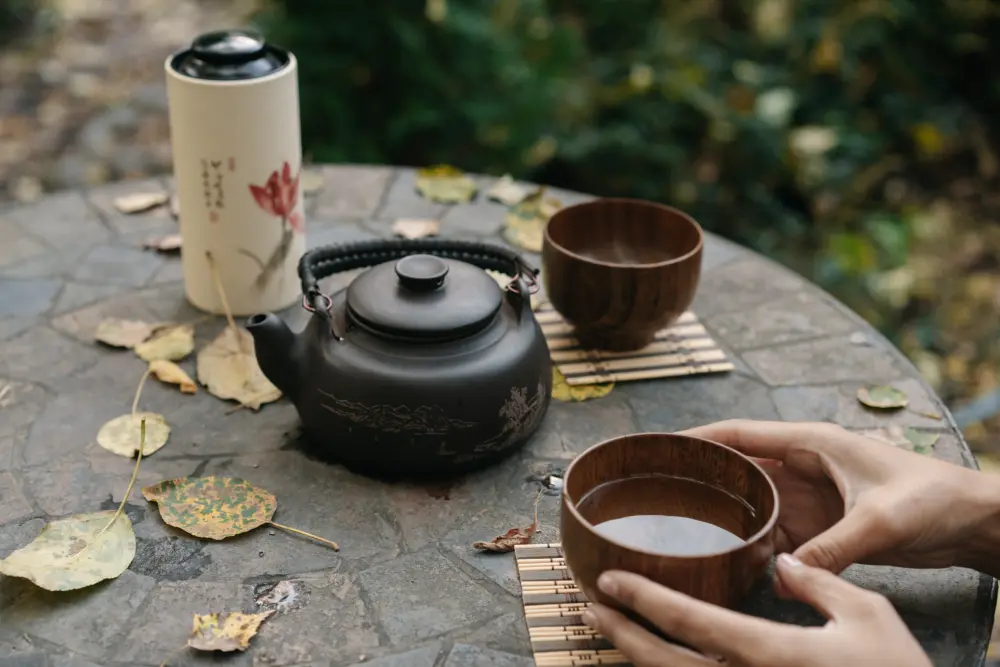A traditional Japanese tea house, or chashitsu, is a small, simple building designed for the practice of the Japanese tea ceremony, also known as Chanoyu or Sado. The tea house serves as a sacred space where guests can experience a sense of tranquility, harmony, and spiritual connection through the tea ceremony.
The design of a chashitsu is based on the principles of wabi-sabi, a traditional Japanese aesthetic that values simplicity, natural beauty, and imperfection. The tea house is typically small, with a low ceiling and a minimalist design that emphasizes the use of natural materials such as wood, bamboo, paper, and clay.
The entrance to a chashitsu is intentionally small and low, requiring guests to bow and enter with humility and respect. Inside, the tea house is typically divided into two main areas: the mizuya, or preparation room, and the tea room, or chashitsu proper.
The mizuya is a small room where the tea host prepares the tea and cleans the utensils. It is also used to store the utensils and tea leaves, which are carefully selected to match the season and occasion.
The tea room is the heart of the chashitsu, and it is here where the tea ceremony is performed. The room typically features a tokonoma, or alcove, where a scroll or flower arrangement is displayed, as well as a hearth, or ro, where the tea is prepared over a charcoal fire.
The tea room is usually designed to accommodate a small number of guests, typically up to four or five people. The guests are seated on tatami mats, which cover the floor and provide a comfortable seating area. The design of the tea room emphasizes simplicity and minimalism, with few decorations or furnishings to distract from the beauty of the tea ceremony itself.
Overall, a traditional Japanese tea house is a small, simple building that embodies the values of simplicity, natural beauty, and spiritual connection. The chashitsu serves as a sacred space for the tea ceremony, where guests can experience a sense of harmony and tranquility through the ritual of making and drinking tea.
What is the basic structure of a traditional Japanese tea house?
The basic structure of a traditional Japanese tea house, or chashitsu, follows a simple and minimalistic design that emphasizes the beauty of natural materials and the principles of wabi-sabi. The chashitsu typically consists of two main areas: the preparation room, or mizuya, and the tea room, or chashitsu proper.
The mizuya is a small room adjacent to the tea room that serves as a space for the tea host to prepare the tea and clean the utensils. It is also used to store the utensils, tea leaves, and other necessary items for the tea ceremony. The mizuya typically features a low shelf or counter for preparing the tea, as well as a sink for washing the utensils.
The tea room is the heart of the chashitsu and is typically designed to accommodate a small number of guests, usually up to four or five people. The tea room is often square or rectangular in shape and features a low ceiling and minimalist design. The walls and ceiling are typically made of natural materials such as wood, bamboo, or washi paper, and the floor is covered with tatami mats made from woven rush grass.
The tea room is divided into two main areas: the tokonoma, or alcove, and the hearth, or ro. The tokonoma is a small recessed area in the wall where a scroll, flower arrangement, or other decorative item is displayed. The hearth is a low area in the center of the room where the tea is prepared over a charcoal fire.
The tea room is often accessed through a small, low entrance that requires guests to bow as a sign of respect and humility. Once inside, guests are seated on the tatami mats and the tea ceremony begins.
Overall, the basic structure of a traditional Japanese tea house is designed to create a sense of harmony, tranquility, and respect for nature. The minimalistic design emphasizes the beauty of natural materials and the importance of simplicity and imperfection in Japanese culture.
What are the rules of Zen garden?
Zen gardens, also known as karesansui gardens, are traditional Japanese gardens that are designed to promote contemplation, meditation, and inner peace. The design of Zen gardens is based on the principles of Zen Buddhism, which emphasizes simplicity, tranquility, and the harmony of nature. Here are some rules that are typically followed when creating and maintaining a Zen garden:
- Simplicity: Zen gardens are designed to be simple and minimalistic, with few or no decorative elements that might distract from the natural beauty of the garden.
- Balance: Zen gardens are designed to create a sense of balance and harmony between the different elements of the garden, such as rocks, sand, and plants.
- Natural materials: Zen gardens are typically made using natural materials such as sand, gravel, rocks, and wood, which are chosen for their simplicity, texture, and natural beauty.
- Raked patterns: One of the most distinctive features of Zen gardens is the use of raked patterns in the sand or gravel. These patterns are designed to represent the ripples of water or the flow of energy through the garden.
- Careful maintenance: Zen gardens require regular maintenance, including raking the sand or gravel to maintain the patterns, pruning plants, and removing debris.
- Mindfulness: The creation and maintenance of a Zen garden is meant to be a mindful and meditative practice, encouraging the gardener to focus on the present moment and find inner peace.
Overall, the rules of Zen gardens emphasize simplicity, harmony, and mindfulness, and are meant to create a peaceful and contemplative environment for those who visit or tend to the garden.
What is the most famous Zen garden in the world?
One of the most famous Zen gardens in the world is the Ryoan-ji Temple Garden in Kyoto, Japan. The Ryoan-ji Temple Garden is a classic example of a karesansui or dry landscape garden, which is made up of rocks, sand, and gravel, and is designed to promote contemplation and meditation.
The garden consists of a rectangular space, approximately 30 meters long by 10 meters wide, surrounded by a wall. In the center of the space are 15 rocks arranged in five groups of three, placed on a bed of white gravel. The rocks are arranged in such a way that no matter where you stand, you can only see 14 of them at once. The exact meaning of this arrangement is unknown and remains a mystery, adding to the garden’s mystique and allure.
The Ryoan-ji Temple Garden was built in the late 15th century and is considered a masterpiece of Japanese garden design. It is widely regarded as a prime example of the Zen concept of ma, or negative space, which is the space between objects that is left intentionally empty to create a sense of harmony and balance.
The garden has become a popular destination for tourists and locals alike, and it is known for its serene and tranquil atmosphere. Visitors are encouraged to sit and contemplate the garden for as long as they like, and the sound of gravel underfoot and the rustle of leaves in the surrounding trees create a sense of peace and tranquility.
Overall, the Ryoan-ji Temple Garden is a shining example of the beauty and simplicity of Zen gardens and has become a symbol of Japan’s rich cultural heritage.
What are the seven Zen principles?
The seven Zen principles, also known as the seven aesthetic principles of Zen, are a set of guidelines that are often used in the creation of Japanese art and design, including gardens, calligraphy, pottery, and architecture. These principles are meant to inspire and guide the artist or designer, encouraging them to create works that are simple, natural, and harmonious. Here are the seven Zen principles:
- Kanso (Simplicity): This principle emphasizes the importance of simplicity in design, encouraging the artist to eliminate any unnecessary elements and focus on the essentials.
- Fukinsei (Asymmetry): This principle emphasizes the beauty of asymmetry and imperfection, encouraging the artist to embrace irregularity and avoid creating perfectly balanced or symmetrical compositions.
- Shizen (Naturalness): This principle emphasizes the importance of using natural materials and designs that reflect the beauty of the natural world.
- Yugen (Subtlety): This principle emphasizes the beauty of subtlety and understatement, encouraging the artist to create works that evoke a sense of mystery and ambiguity.
- Datsuzoku (Freedom): This principle emphasizes the importance of breaking free from conventional thinking and traditional rules, encouraging the artist to be innovative and experimental.
- Seijaku (Tranquility): This principle emphasizes the importance of creating works that evoke a sense of calm and tranquility, encouraging the artist to use empty space and quietness to create a sense of harmony.
- Koko (Austerity): This principle emphasizes the beauty of simplicity and austerity, encouraging the artist to create works that are free from excessive ornamentation and decoration.
These principles are not meant to be strict rules, but rather guidelines that inspire creativity and encourage the artist to express their individuality and unique perspective. By embracing these principles, artists and designers can create works that are beautiful, harmonious, and reflect the core values of Zen Buddhism.




Be First to Comment